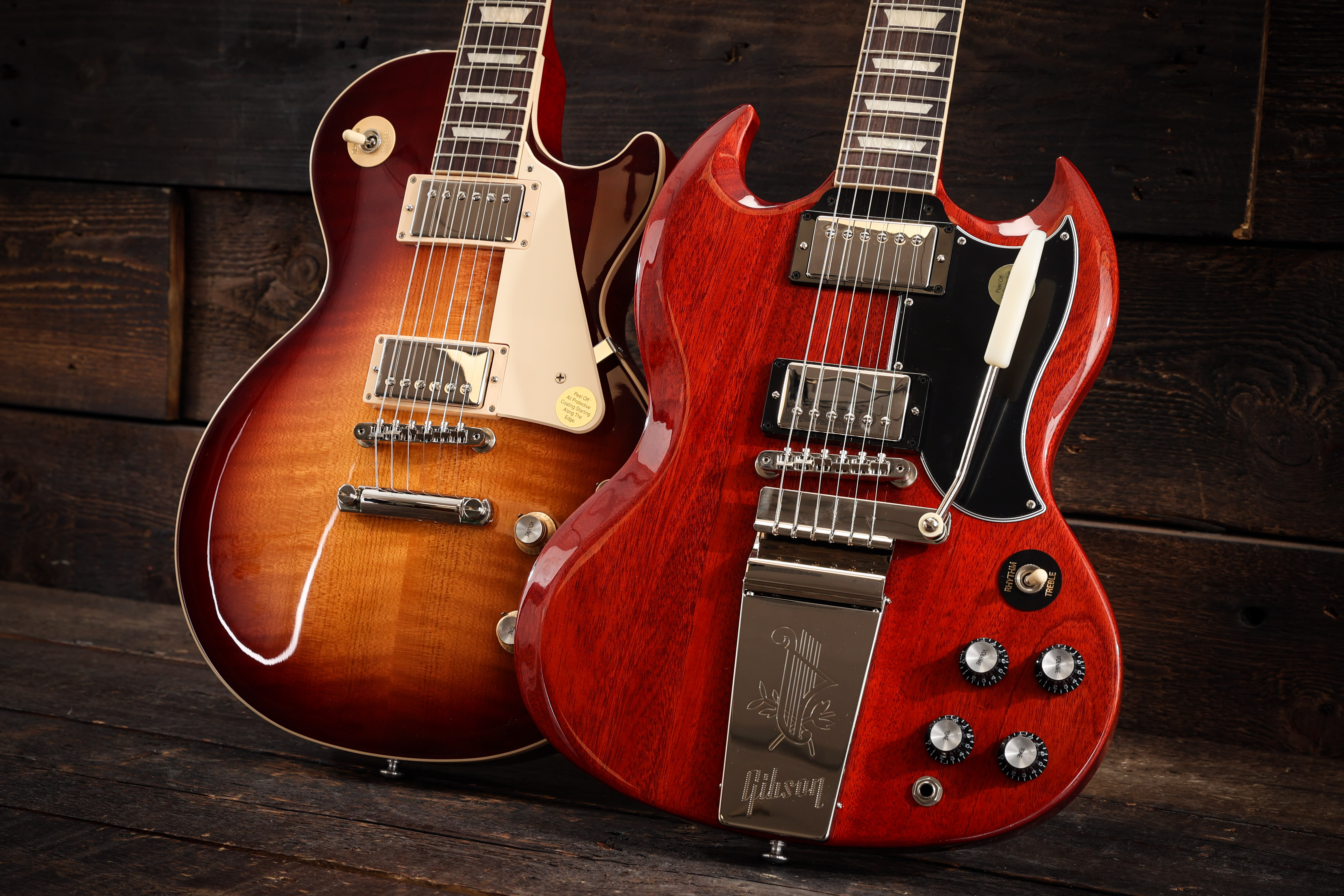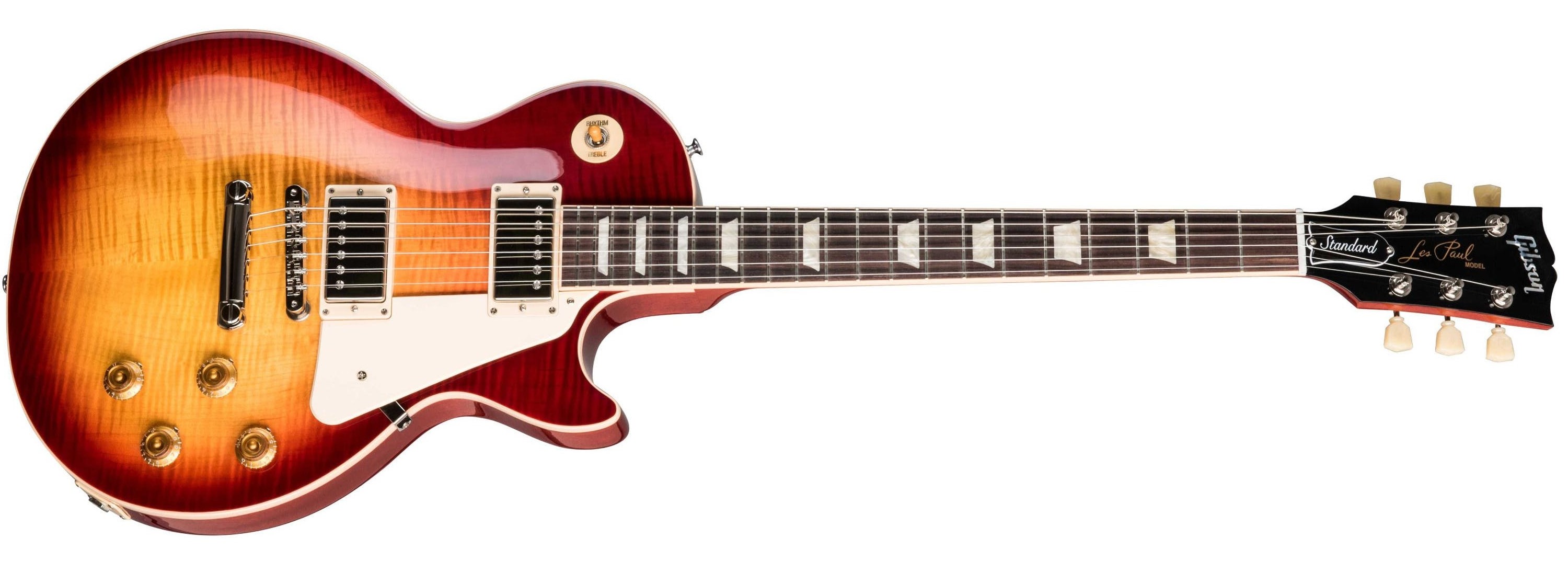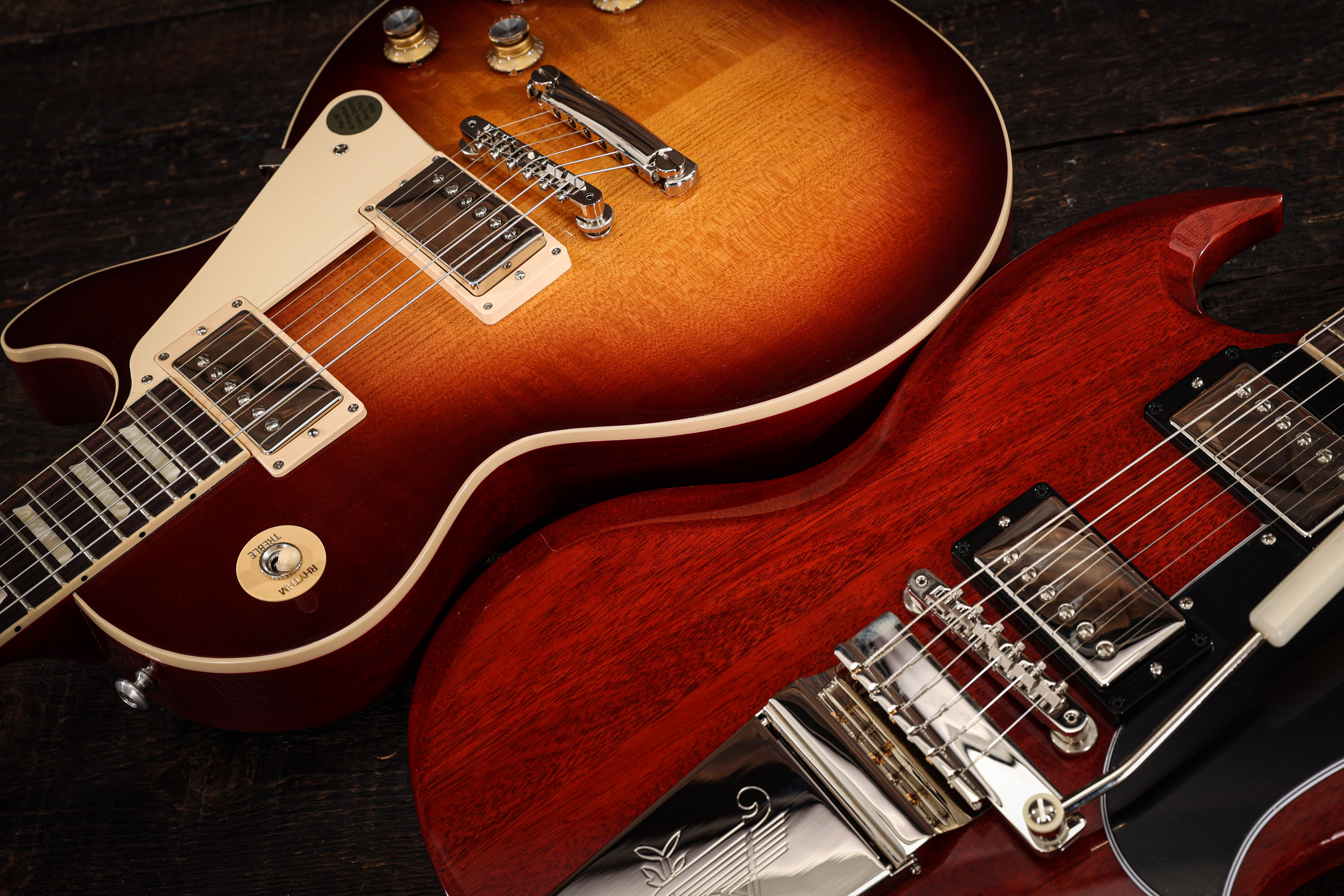Two guitars. Endless riffs. When you think of the Gibson Les Paul and the Gibson SG, you’re thinking of pure rock ‘n’ roll history. There’s no doubt both guitars have some serious pedigrees, and they each sound phenomenal. But despite sharing some common DNA, they actually offer very different playing experiences.
In this guide, we’ll pit Gibson Les Paul vs Gibson SG, breaking down where each guitar came from and what makes them so unique. Whether you’re chasing thick, sustaining tones or something lighter and decidedly sharper, by the end of this guide, we’ll help you figure out whether you’re Team Les Paul or Team SG!
Table of Contents
- The History of the Gibson Les Paul and SG
- Famous Gibson Les Paul and SG Players
- Gibson Les Paul vs SG: Head-to-Head Comparisons
- Gibson Les Paul vs SG: FAQs
- Gibson Les Paul vs SG: Which One is Best for You?
- Further Reading

The History of the Gibson Les Paul and SG
The Birth of the Les Paul
The Gibson Les Paul can trace its origins all the way back to 1952, when factory manager John Huis developed the instrument in collaboration with legendary jazz guitarist and recording pioneer Lester William Polsfuss – better known as Les Paul himself! The guitar originally featured a pair of P-90 pickups, which were swapped out in favour of dual humbuckers in 1957. But in 1961, after a spell of poor sales, Gibson gave the Les Paul a facelift – including a brand-new look that we’re pretty familiar with today!

How the SG Came to Be
By the early ‘60s, Gibson was looking to breathe new life into the Les Paul design, and in 1961, they introduced a radical redesign of the guitar, featuring a thinner, double-cutaway body and sharper contours. The new axe was still marketed under the Les Paul banner, but by all accounts, the man himself wasn’t a big fan of the LP 2.0’s look and asked Gibson to remove his name from the model. Thus, the SG – short for ‘Solid Guitar’ – was born.
Though originally intended as a replacement, the SG’s snappy tone, lighter feel, and edgy looks quickly built up a dedicated following, carving a legacy all its own.
Return of the OG
In 1968, the original Les Paul design made its long-awaited comeback. Despite the now-booming popularity of the SG, demand from musicians and dealers prompted Gibson to reintroduce the original Les Paul, complete with its now iconic single-cutaway body. This marked the beginning of a new era for both the Les Paul and the SG, cementing their places as two of the most legendary electric guitars of all time.

Famous Gibson Les Paul and SG Players
Amazing specs and unforgettable aesthetics are one thing, but the real legacy of a guitar is shaped by the legends who wield it. And in the case of the Les Paul and SG, the list of players who have relied on them is truly a who’s who of rock royalty.
Famous Les Paul Players
Once Gibson reintroduced the Les Paul in the late ‘60s, it didn’t take long for heavy-hitting guitarists to put it to good use. Led Zeppelin’s Jimmy Page and Billy Gibbons of ZZ Top were early adopters, while ’70s rock heavyweights like Marc Bolan and Ace Frehley of KISS also made the Les Paul their weapon of choice.
In the ‘80s, icons like Slash of Guns N’ Roses brought the Les Paul roaring back into the rock spotlight, and Gary Moore wielded it with unmatched expression and power. But don’t think the Les Paul is a guitar only for years gone by – it’s certainly still relevant today. Adam Jones of Tool harnesses its weighty tone for his intricate alt-metal soundscapes, while Zakk Wylde’s hypnotic-patterned Les Paul is as recognisable a part of his persona as his impressively Viking beard!
Famous SG Players
Few players are as closely linked to the SG as Angus Young of AC/DC. Young’s unmistakable schoolboy stage presence and searing solos were a huge part of hard rock in the ‘70s – and beyond. But going in an undeniably darker direction was Tony Iommi. As guitarist of the genre-defining Black Sabbath, Iommi took the SG and literally used it to invent heavy metal, complete with down-tuned riffs and sinister tones.
But the SG is so much more than heavy riffs and searing leads. Frank Zappa used his SG as a vehicle for avant-garde virtuosity (and eccentricity!), while Derek Trucks channels its smooth sustain into slide guitar mastery with the Tedeschi Trucks Band. Thom Yorke of Radiohead has also frequently been spotted wielding an SG for his angular, atmospheric songwriting, and System of a Down’s Daron Malakian used one to craft some of nu-metal’s most chaotic yet memorable riffs.
Gibson Les Paul vs SG: Head-to-Head Comparisons
Now that we’ve explored the history and heritage of both guitars, it’s time to compare the current line-ups side by side. From vintage vibes to modern playability, entry-level price tags to high-end luxury, there’s a Les Paul or SG out there with your name on it!
The Standards: ‘50s and ‘60s Les Paul vs SG Standard and SG Standard ’61
If you’re looking for those classic Gibson tones and traditional aesthetics, then this is where your search ends. Think “Gibson” and, chances are, these are the guitars you’re thinking about.
The Les Paul Standard comes in two flavours: the ‘50s model, which has a chunkier neck and vintage-style ‘Burstbucker’ pickups, and the ‘60s model, with a slim taper neck and brighter tone. Both models have that classic carved maple top on a solid mahogany body for the signature Les Paul weight and sustain.



Responses & Questions